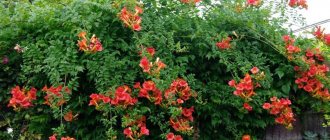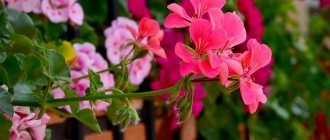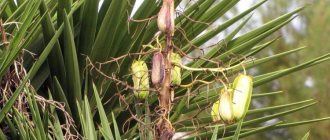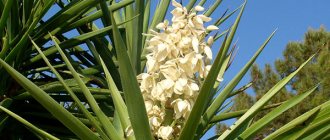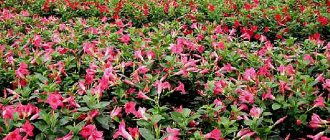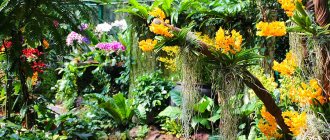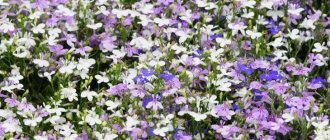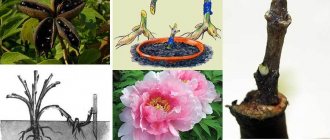The climbing flowering plant Mandevilla, or Dipladenia, is part of the Kutrovaceae family. Under natural conditions, such a plant can be found in Central and South America. According to various sources, this genus includes 120–190 species, among which there are both annuals and perennials. Many gardeners also call indoor greenhouse and garden mandevilla jasmine, or Brazilian balsam, or Chilean jasmine, or Bolivian rose, or Mexican tree of love. This genus received its scientific name "Mandevilla" in honor of Henry J. Mandeville, who was an English diplomat and amateur gardener while serving in Argentina. Translated from Greek, “dipladenia” means “having double glands.” Indoor dipladenia is a very impressive plant, which is distinguished by its capriciousness and high demands on growing conditions and care. However, it is still becoming more and more popular with flower growers every year.
Brief description of cultivation
- Bloom . Lush and long-lasting (from the last days of March to November).
- Illumination . Needs bright but diffused light. It is recommended to place it on a windowsill with a western or eastern orientation.
- Temperature regime . During the growing season - from 18 to 26 degrees, and during the dormant period - from 12 to 15 degrees.
- Watering . It should be plentiful with a frequency of two or three times a week. The soil mixture in the pot is moistened only after its surface has dried to a depth of 10 to 15 mm. On very hot days, the bushes are sometimes watered twice a day. Starting in September, a gradual reduction in watering is carried out.
- Air humidity . Should be elevated. To do this, the flower is kept in a special glass display case, or the pot with the plant is placed on a tray filled with wet pebbles.
- Fertilizers . Feeding begins in March, from this time liquid nitrogen fertilizers are added to the substrate once every 7 days. However, with the beginning of the formation of buds, the flower should be fed with potassium-phosphorus complex fertilizer, which is applied systematically once a week until August.
- Trimming . It is carried out systematically in the autumn, immediately after the end of the growing season.
- Transplant . If necessary, after the root system of the bush becomes very crowded in the flower pot. Adult bushes are not replanted; instead, the top layer of soil mixture in the pot is regularly replaced.
- Reproduction . By cuttings and seed method.
- Harmful insects . Whiteflies, mealybugs and spider mites.
- Diseases . Powdery mildew.
Temperature for growing the plant
The best conditions for growing Dipladenia is the temperature - in the spring from 20 ° C or more. In winter, the flower does not tolerate temperatures below 15-18 °C. Dipladenia requires a sunny position (it is better to place a south window in the apartment), a warm and humid climate. As the plant grows, you should:
- water regularly (the soil should be evenly moist);
- avoid waterlogging (excess water is not allowed);
- periodically moisten the leaves;
- systematically fertilize.
Apply fertilizers every week, from March to August.
Features of dipladenia
Mandevilla is a lush evergreen vine that grows rapidly. The stem is climbing, woody, it is decorated with oppositely arranged rich green leaf plates, they are glossy, leathery, oval in shape to the touch. If you break a leaf, milky juice will ooze from it, which is poisonous.
In indoor conditions, dipladenia is cultivated as a climbing plant or compact bush. The fragrant funnel-shaped flowers consist of 5 petals, which can be pink, red, white or crimson. On an adult bush, up to 80 flowers can open at the same time, and they will delight you with their beauty for more than a week.
MANDEVILLA OR DIPLADENIYA CARE SECRETS AND TRANSPLANTATION | ONLY PERSONAL EXPERIENCE
Features of the appearance of mandevilla
Dipladenia is an evergreen compact vine that grows up to 1.5 meters in length. It has bright green glossy foliage and numerous fragrant flowers, 10-12 cm in diameter.
The flowers have different colors: white, red, pink in shades. There are semi-double varieties. Each flower stays open for up to 12 days. With proper care, the plant can bloom in its first year.
In order for the flower to feel comfortable, and for the flowering to be abundant and delight the housewife all year round, it is worth taking care of supports and a large pot for the vine.
Mandevilla care at home
Illumination
In order for indoor mandevilla to grow and develop well, it needs to be provided with conditions that are very similar to natural ones. As for lighting, the vine needs a lot of bright light, otherwise it will not be able to reach the peak of its attractiveness. This flower grows best on windows with a western or eastern orientation. The bush can also be placed on a southern windowsill, but in this case it will have to be shaded during the midday hours from direct sunlight, because they can damage the foliage.
Temperature
In winter, dipladeniya should be kept cool (from 12 to 15 degrees), and in summer it is moved to a warmer place (from 18 to 26 degrees). However, if the room in the summer is warmer than 26 degrees, the plant will not suffer from this; on the contrary, the color of the flowers will become more saturated and bright.
The liana needs fresh air, so the room where it grows will have to be ventilated very often. But do not forget to protect the flower from drafts, as they can destroy it. In the summer, if possible, it is transferred to the veranda, balcony or garden, and choose a place that is protected from drafts, direct rays of the sun and wind.
Trimming and garter
Since mandevilla is a climbing plant, when growing at home, do not forget to tie it up in a timely manner, as well as prune it. The height of the support should be 1.5 times the size of an adult bush. Its stems will climb the support and gradually take over it completely.
Watering
Like other plants that come from the tropics, mandeville needs timely, abundant watering. It is necessary to moisten the substrate in the container only when it dries 10–15 mm deep. For irrigation, which is carried out on average twice or thrice a week, exclusively warm water is used. During hot, dry periods, you have to water the vine once or twice a day. In September, the quantity and abundance of watering begins to be gradually reduced, but make sure that the vine does not begin to fly off its leaves due to lack of water.
Remember that this crop reacts extremely negatively to lime. In this regard, the water with which the flower is watered must be settled (at least 24 hours) or filtered. Once every 30 days, add enough fresh lemon juice or citric acid to the water intended for irrigation so that it tastes slightly sour.
Air humidity
The plant needs high air humidity at any time of the year. In this regard, it is recommended to grow it in a special glass display case. If you do not have the opportunity to place the flower in the display case, then small wet pebbles are poured into the tray, and the pot is placed on it. You can also place the container with the vine in a large flowerpot. After this, all the free space between the walls of the pot and the pot is covered with damp sphagnum moss or peat.
To increase air humidity, you can spray the foliage with warm water every day. This procedure is especially recommended for the flower during flowering and bud formation.
Top dressing
When growing such a flower, do not forget to feed it in a timely manner. In order for the vine to be decorated with spectacular leathery leaves, it must be fed with fertilizers containing nitrogen. However, immediately after buds begin to appear on the bush, and even during flowering, it is fed with phosphorus-potassium fertilizers. For fertilizing, liquid fertilizer is used, and it should be added to the substrate regularly once every 7 days, but not all year round, but from March to August. In winter, the liana does not need feeding.
Dipladenia transplant
Mandevilla grows best in a loose, moderately acidic substrate rich in nutrients. A soil mixture consisting of sand, peat, humus, leaf and turf soil is well suited, and they are taken in equal parts. Instead of sand, you can take fine perlite or expanded clay, thanks to them the soil mixture becomes looser, as a result of which the root system of the bush can receive a sufficient amount of oxygen.
Transplantation is carried out only when necessary, or rather, after the root system becomes very crowded in the container. To do this, inspect the drainage holes at the bottom of the pot; if the roots are peeking out of them, then the mandevilla must be replanted. When the vine becomes an adult, it is better not to replant it; instead, systematically replace the top layer of soil mixture in the pot with a new one.
Trimming
This flower is fast growing and therefore needs regular pruning. If you don’t do this, the bush will grow very quickly, and after a while you will have a real jungle in your apartment. The formation of buds occurs on the stems of the current year of growth. In this regard, in the autumn, the vine must be pruned at the very end of the growing season. Unbranched old stems are shortened by 2/3, and branched shoots are shortened by 1/3 or ½ of the length after forking. As a result, after pruning, only 1/3 of the unbranched shoot should remain, and the third part of the branched shoot should remain after the fork. If the plant is pruned correctly in the fall, it will survive the winter well and will actively grow young stems during the next growing season.
Wintering
The dormant period of Dipladenia begins in late autumn and ends in early spring. During this period, the vine should be in a room in which it should not be colder than 12 degrees and not warmer than 16 degrees. After the bush is pruned in the fall, a sharp reduction in watering is carried out. During the dormant period, it is watered only after three days have passed after the substrate in the container has completely dried.
In the spring, when the mandevilla begins to awaken, it is moved to its usual place, after which the usual summer watering regime is gradually resumed. From this time on, fertilizers begin to be added to the soil mixture.
Dipladenia - proper care during the flowering period
Causes of yellowing and falling leaves
May be caused by insect pests. If after a visual inspection they are not found, then the plant’s watering schedule will need to be reconsidered. Deviations from the norm in any direction weaken the plant.
Irregular, over or under watering
Dipladenia or Mandevilla is a moisture-loving plant. In spring and summer, during flowering, it is watered abundantly. But the earthen ball should not be allowed to be constantly wet; between waterings, the soil surface should dry out by 2-3 centimeters. In winter, when the plant begins a dormant period, watering is reduced, preventing the clod of earth from completely drying out. The lower the temperature in winter, the less frequent watering should be. Water the vine with well-settled water without lime impurities.
It is best to place the pot in a tray of water on an inverted saucer so that the bottom of the pot does not touch the water itself. This will help maintain a certain humidity.
Temperature
Low temperature is the most common and common cause of yellowing leaves.
Dipladenia needs a lot of light, but without direct sunlight. An east window is best suited for this. It will be too hot for her on the south window. With a lack of light, Dipladenia's stems become excessively elongated and flowers rarely bloom. The plant is in dire need of fresh air, so frequent ventilation will only benefit it.
In the warm season, it is recommended to place dipladenia on a balcony, veranda or garden, providing it with shade. Southern Dipladenia loves warmth and develops well at temperatures from 20 to 26 ° C and even more.
At elevated temperatures, the color of the plant's flowers becomes brighter and more saturated.
In winter, with reduced daylight hours, the plant remains dormant, slowing down its growth. At this time, dipladenia needs a cool room with a temperature of 15 to 17°C, but not lower than 12°C.
Wrong choice of location
The tropical guest loves it when it is light and warm. Therefore, it would be optimal to place it on the east side. Then the sun's rays will be able to provide the necessary amount of heat and light. Prolonged exposure to ultraviolet light can weaken the plant and cause sunburn. To avoid this, you do not need to expose the flower pot directly to the sun, provide light diffusion or partial shade.
In the warm season, it is recommended to plant Dipladenia in the soil outdoors. The exception is the northern regions, where low nighttime ground temperatures are recorded even in summer.
Pests
Pests can invade dipladenia due to its weakening by improper or insufficient care, for example:
- watering with poor quality water;
- growing in soil contaminated with larvae or fungi;
- kept at too low a temperature or in insufficient lighting;
- poor hygiene: your plant is covered in dust.
Reproduction methods
Growing from seeds
An adult dipladenia has a fairly high price in a flower shop, so it may not be affordable for every gardener. But if you really want to decorate your home with such a vine and are not afraid of possible difficulties, then try to grow it from seeds, and seed material of various varieties of mandevilla is available for sale.
Take a container with holes at the bottom for drainage and fill it with a slightly acidic, light and loose soil mixture, into which the seeds are sown. The crops are transferred to a well-lit (the light should be diffused) and warm (from 22 to 28 degrees) place, and they are provided with regular watering, while making sure that the substrate is always a little damp, but do not allow liquid to stagnate in it.
You will have to wait a very long time for the first shoots, about 2–4 months, and throughout this time you will need to systematically water the crops and also remove condensation from the surface of the shelter. After the emerging seedlings have formed 2 true leaf plates, they are picked into individual cups that have holes at the bottom for drainage, and the substrate is used the same as for sowing. After some time, when the bushes grow, they are transplanted into permanent containers.
Cuttings
From the second half of spring to mid-summer, the vine can be propagated by cuttings. The upper parts of young stems are taken as cuttings in spring, and sections of lignified mature shoots are taken in summer. When working with dipladenia, remember that its shoots and foliage contain juice that contains poison, so do not forget about precautions: protect your hands with rubberized gloves and do not allow the juice to come into contact with mucous membranes and skin.
For rooting, the cuttings are planted in small cups, which are filled with a moistened substrate, which includes peat and sand (1:1). Also, if desired, you can pour one part of dry sphagnum into it. When planting for rooting, the cuttings must be deepened to the first pair of leaf blades. Then it is put into a mini-greenhouse, where it should always be very warm (no colder than 25 degrees). Bottom watering (through a tray) is recommended for cuttings. Most often, after 30 days, the cuttings grow their own root system, and when this happens, they are planted in permanent pots. There are cases when gardeners root Dipladenia cuttings in a glass of water. And when they grow roots 10–20 mm long, they are planted in pots filled with soil mixture.
If everything is done correctly, the cuttings should easily take root. But there are times when terry mandevilla cuttings do not want to take root. In this case, the solution will be to grow terry varieties from seeds.
Dipladenia - propagation by cuttings
Instructions for growing Dipladenia
To grow Dipladenia, the cutting method is used.
- Cut off young, but not woody, shoots in spring and summer. Make a cut at an angle, taking 4 leaves.
- Remove the bottom 2 leaves.
- Prepare a small container with expanded clay at the bottom as a drainage layer.
- Mix sand, peat, turf and leaf soil in equal proportions.
- Root the shoots and create greenhouse conditions so that the air humidity is high. To do this, cover the container with film and ventilate it daily for several minutes.
- Use phytohormones or warm the soil to improve rooting.
- Harden off the cuttings as soon as the first shoots appear. To do this, increase ventilation gradually.
- At the final stage, transplant the plants in threes into a pot with a diameter of 12 cm.
Diseases and pests
Possible problems
If the mandevilla is not properly cared for or kept in unsuitable conditions, various problems may arise, for example:
- Yellowing of foliage . If the foliage on the bush turns yellow in the warm season, this means that the air humidity in the room is very low. And if yellowing is observed in winter, this may be due to the fact that the room is too cold. Also, yellowing leaves may be a sign of the presence of pests on the vine or its damage by disease.
- Flying leaves . The leaves of such a plant turn yellow and then fall off due to the fact that the room is very cold or the bush is not watered correctly (lack of water or its stagnation in the substrate).
Harmful insects
As a rule, harmful insects settle on those bushes that are weakened by poor care, for example:
- unsuitable water is used for irrigation;
- the substrate used to grow the flower is infected with fungi or pest larvae:
- the plant does not have enough light or is too cold;
- Dust is not removed from the foliage in a timely manner.
As a rule, all these violations most often cause whiteflies, mealybugs or spider mites to settle on the vine. Most often, whiteflies settle on those bushes that are outdoors in the summer. In this regard, when you move the bush back into the house in the fall, carry out a mandatory inspection of its foliage. The fact is that it is on the underside of the leaf blades that whiteflies, which are similar in appearance to a small moth, prefer to hide. If you see pests on a vine, then it must be sprayed with an insecticide (Aktara, Aktellik or Fitoverm), otherwise, after the mandevilla is in the house, the pests will quickly move to other indoor plants.
Mealybugs are sucking pests that make punctures in stems and foliage and suck out the sap from them. This pest is also considered one of the main carriers of viral diseases. You can understand that a bush is affected by scale insects by the following signs: the foliage loses its turgor, the bush becomes lethargic, the buds are deformed, and insects similar to small mosquitoes fly around the plant. Also, lumpy formations appear on the surface of the substrate in the pot, and on the flower itself you can see small white oval-shaped bugs. To get rid of scale insects, the plant can be sprayed with garlic infusion, for the preparation of which a head of garlic is passed through a press and then combined with 1 tbsp. just boiled water. The infusion will be ready in four hours, then it is used to wash those areas of the bush that are affected by the pest. If necessary, the following chemicals can be used to control the pest: Aplaud, Phosfamide and Bi-58.
The greatest danger to the plant are spider mites, which are arachnids. Their appearance on the bush is facilitated by dry air in the room. If black or brown dots form on the foliage, then conduct a thorough inspection of the plant, paying special attention to the underside of the foliage, since this is where ticks prefer to hide. The presence of a pest is also indicated by the thinnest web found on the vine. Wipe the foliage of the plant with slightly sour water in which a little soap is dissolved. If this method turns out to be ineffective in controlling the pest, then the bush is sprayed with an acaricide solution, for example, Fitoverm. Increasing the level of air humidity in the room also helps to cope with the pest.
Diseases
Of all the diseases, the greatest danger to dipladenia is powdery mildew. The affected bush develops a whitish coating on the surface of all above-ground parts. In order to save a sick flower from this fungal disease, it is treated with a solution of colloidal sulfur (1%). To do this, the product is applied to all affected areas of the plant, and after 24 hours it must be washed, giving it a warm shower. Most often, in order to completely defeat the disease, the flower has to be treated twice or three times.
There are no non-flowering Mandeville Dipladenias.
When it comes to flowers, Dipladenia-Mandevilla cannot be accused of being stingy. Liana, who is not even a year old, is already trying to bloom. And grown plants bloom from the beginning of spring until the end of autumn. They are ready not to stop in winter. But short daylight hours and cool air slow down all processes. We'll talk about rest later. And now about the difficulties associated with flowering.
For mandevilla, flowering is the purpose of life
There are simply no mandevillas that do not bloom at all. Some owners of royal vines complain that they bloom sparingly, a dozen or two flowers per season, and that’s all. Most likely, it is not the capricious nature of the royal person who is to blame, but the neglect of the conditions of detention and the peculiarities of care.
Mandevilla blooms when it is not even a year old
For example, a plant is deprived of winter rest. Or he didn't get his hair cut. And flowers appear only on young shoots. Where will the flowers come from if there are no young shoots? High-quality flowering cannot be achieved if the vine does not have enough light. It happens: the buds set and fell off because they forgot to water the plant. The situation is the same with nutrition. There are few buds, the flowers have turned pale and shredded - your vine is hungry. Feed it with a complex with phosphorus and potassium - flowering will resume.
How does a plant survive winter?
In South America, in its homeland, dipladenia can easily do without winter rest. Because there is no winter, with frost, darkness and other joys, in her native land. In our harsh latitudes, the royal vine has slightly changed its habits. Flowering in our climate takes a lot of her energy. Therefore, having moved into the rooms, the Mandevilla got used to taking vacations in the winter, from late November to February.
During this period, the heat-loving plant wants a slight coolness, 16–18 degrees. Liana goes on a dry diet and does not take food. In winter, it should be watered only after the soil has completely dried, following the rule: the colder it is, the less often you water it.
Autumn pruning
As already mentioned, without a haircut, the royal vine will lose all its grandeur. Dipladenia produces buds only on new shoots. This means that if pruning is not done, expect sparse flowers at the ends of elongated stems.
Flowers appear only on young shoots
Dipladenia is trimmed not in the spring, like many plants, but in the fall, when it has finished blooming. Or in February before growth begins. In some cases, the vine will have to be cut twice. Experienced flower growers recommend not sparing long lashes, but shortening them by half or a third. You need to leave the stem about three to four pairs of leaves from the fork or soil on the young plant. Young shoots will develop from their axils. And you will receive a royal vine in all its blooming glory. Do not throw away the cut stems; they are propagation material.
And don't forget to wear gloves when pruning the vine!
Types of dipladenia with photos and names
Not too many types of mandevilla are grown by gardeners indoors. Below we will describe those that are most popular in culture.
Dipladenia splendens
This species is a climbing evergreen plant, cultivated by gardeners most often as an hanging plant. While the shoots are young, there is pubescence on their surface, and they are decorated with lush oval-shaped foliage, which reaches about 20 centimeters in length, and has a heart-shaped base and a pointed apex. As the stems grow (they can reach 4–5 m in length), they become exposed, and the amount of foliage on them gradually decreases. During flowering, loose clusters are formed, consisting of 6 flowers, white on the inside and deep pink on the outside, which reach about 100 mm in diameter. The bracts are purple.
Bolivian Dipladenia bolewiensis
This heat-loving species comes from Bolivia, and it is most popular among gardeners. And they fell in love with it for its long stems, which are decorated with rich green ovoid leaf plates, reaching 50–80 mm in diameter. The racemose inflorescence is formed on axillary peduncles, and it consists of three or four white flowers, reaching up to 50 mm in diameter. The throat of the flowers is yellow, the tube is cylindrical in shape, and there is also a saucer-shaped bend.
Dipladenia eximia
This evergreen vine has smooth shoots that are pale red in color, and they are decorated with rich green, round-ovate leaves that reach 30–40 mm in length. The racemose inflorescences consist of 8 flowers, reaching up to 70 mm in diameter, their tube length is about 50 mm, the calyx is red, and the corolla is usually pinkish-red.
Dipladenia sanderi
Thick oval-shaped leaf plates with a slightly pointed upper part grow on smooth shoots, the length of which reaches 50 mm and even more. During flowering, axillary brushes appear, which include from 3 to 5 rich pink flowers, reaching up to 70 mm in diameter, their throat is yellow.
Dipladenia laxa
This highly branching species can grow very large in indoor conditions, so it requires a lot of space. The warty shoots can be about 5 meters long; they grow opposite leaf plates of an emerald green hue and an oblong-ovate shape. The front surface of the foliage is smooth, but the back surface has pubescence; it can reach about 10 centimeters in length. The inflorescences include from 5 to 10 corrugated flowers of a creamy white hue, which have a diameter of about 90 mm.
The most popular of all mandevilla varieties are the following:
- Allamandou . This plant is distinguished by its unpretentiousness and large, rich yellow flowers.
- Cosmos White, Fair Lady and Summer Snow . These varieties bloom long and luxuriantly with snow-white flowers.
- Pink Parfait . The plant is decorated with fragrant multi-petaled flowers. The variety is also called “Thai rose”.
- Red hood . The flowers are cherry pink.
- Scarlet Pimpernel . In the sun, the flowers of such a vine can shimmer in all possible shades of red.
- Yellow . The flowers of this variety shine with gold.
- Cosmos Rose . The bush is decorated with fleecy large flowers.
- Classic Ed . This large vine has deep red flowers.
- Laksa , or Chilean Jasmine . This Argentinean variety is distinguished by the sharp scent of gardenia.
- San Parasol Crimson . The petals of the flowers are pointed, like those of fragrant tobacco.
Mandevilla (Dipladenia) is an amazingly beautiful flower. Care, propagation.
Why doesn't dipladenia bloom?
When dipladenia grows in the house, cultivation and care must be followed according to all the rules, otherwise flowering will not be achieved.
Although it is possible to plant this plant in open ground, it must be taken into account that it is very vulnerable to low temperatures. When the question arises about why dipladenia does not bloom, one answer may be that the temperature is too low.
How to make Dipladenia bloom at home
It may happen that this plant does not produce flowers at all. In this case, it can be assumed that he lacks the nutrients he receives from feeding. It can be made to bloom if you care for the plant properly.
Sometimes the reason is that the plant needs more light. It is important to avoid direct sunlight.
Why do Dipladenia leaves turn yellow and fall off?
Sometimes you can see that the leaves turn yellow and curl, and then dry out and fall off. The reason for this may be excessive watering. Excessive moisture causes plant disease.
If the vine freezes in winter, this can also cause the leaves to yellow and fall off.
If pests attack, you will need to apply appropriate insecticides.
Note! Sometimes the leaves shed intensively if the basic rules of care are violated. The cause can usually be poor watering, insufficient fertilizing and too dry air.
Transfer
Young Dipladenia grow quickly, so they need to be replanted 2-3 times a year. Adults are transplanted as needed: when the roots appear from the drainage holes.
The optimal time for transplanting dipladenia is February-March.
The pot for the vine should be voluminous and deep, with a diameter of about 25 cm. The best method of replanting is transshipment. In adult specimens, only the top layer of soil can be changed annually.
Only absolutely healthy plants are replanted. If the vine’s growth has slowed down or any signs of disease have appeared, it is better to replant it with a complete replacement of the soil. At the same time, the root system is carefully cleared of old soil and inspected. All dry, rotten and darkened roots must be removed and the flower replanted in fresh soil.
Actions after acquiring dipladenia: transportation, transplantation, selection of soil and container
Dipladenia is a heat-loving flower, so it is better to purchase it in the spring and summer, at which time transportation will not be difficult. After purchasing the plant, it is not recommended to replant it immediately; you need to give it time to acclimatize to the new growing conditions. It is advisable to transplant after 7-10 days.
Dipladenia prefers moderately acidic soil rich in nutrients. When replanting, you need to choose a pot 3-5 times larger than the previous one.
Feeding and fertilizer
It is not necessary to feed, but if from April to August you add regular flower fertilizers to the water once every two weeks, you can achieve more abundant flowering and much brighter, richer buds.
In fact, in its homeland, the plant blooms all year round, but it is hot there all the time and, in fact, there is no winter with low temperatures and shorter days. In Europe, Asia, and North America, this is difficult to achieve, but it is possible, but not by fertilizing. If in the autumn-winter period you increase the day due to artificial lighting, do not forget about fertilizing, watering and temperature and humidity, then dipladenia will delight you with large, amazing flowers throughout the year. At the same time, all recommendations in terms of watering, daylight hours, and temperature must correspond to the spring-summer needs of the flower. Otherwise, during the cold season, it will temporarily stop development and growth.
The most common mistakes gardeners make when growing Dipladenia
Mistake #1. Caring for a plant without gloves leads to skin irritation. Keep the plant out of the reach of children, as Dipladenia contains a substance that has a negative effect on the heart.
Mistake #2. Incorrectly selected or prepared soil. The easiest way is to purchase soil for azaleas or rhododendrons, which is excellent for growing Dipladenia. Be sure to completely change the soil to a new one every time you replant.
Mistake #3. Insufficient lighting leads to the formation of a large number of long whiskers. The plant stops blooming.
Popular varieties
In total, there are more than four dozen varieties and varieties of this tropical plant in nature. You should familiarize yourself with the most popular ones in detail.
Loose
A distinctive feature of loose dipladenia is the presence of numerous short shoots on the sides of the trunk. The leaves are medium in size and have a grayish-green tint. Loose apical inflorescences consist of snow-white or soft cream flowers with pointed petals. The plant is highly resistant to temperature changes and is able to quickly grow green mass.
Sandera
The average height of the plant is three meters. Each inflorescence contains 3-5 flowers of rich yellow-pink color. The leaves are small in size and pointed in shape.
Excellent
This is the most elegant and delicate variety of Dipladenia. The thin stem of the vine with slight pubescence has a pink color. The flowers of an expressive pink hue, collected in a brush, contrast effectively with the medium-sized green leaves.
Bolivian
A variety of vines for indoor growing. The stem has slight hairiness. Dark green leaves of miniature size with a shiny, attractive surface. Fragrant white flowers are collected in brushes.
Brilliant
A plant with tall shoots and large oval leaves with shine. The color of the flowers is very expressive - deep pink with a contrasting crimson core.
Red
A characteristic feature of this variety is the rich red color of the inflorescences against the background of dark green foliage. The plant is large, hardy and resistant to temperature changes.
Lighting
Mandevilla needs bright, intense lighting. Any, even short exposure to direct rays of the sun will benefit her.
The optimal place for dipladenia will be south-east, south-west or south windows . However, in the summer midday heat, the plant should be shaded, for example, using a translucent curtain.
With a lack of light, the vine becomes very elongated, loses its decorative effect, and flowering becomes very sparse or absent altogether. On warm summer days, dipladenia can be taken to a shaded balcony or under a tree in the garden.
